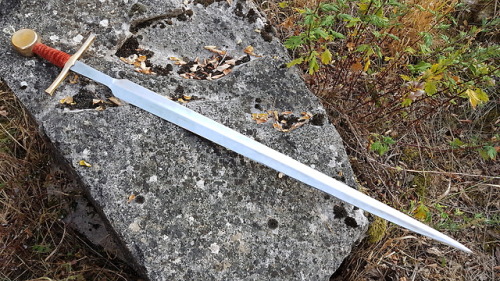Forum Replies Created
-
AuthorPosts
-
Thaeris
ParticipantVery interesting read. Actually, that article linked to a similar article which may also be applicable in developing a setting:
https://www.atlasobscura.com/articles/musical-cryptography-codes
Thaeris
ParticipantCheck out this highly unusual reproduction made by Dr. Fabrice Cognot:

https://www.historicalbladesmith.com/post/178269848513/a-burgundian-arming-sword-late-xvth-century
…I recall seeing a children’s book in my elementary school that featured characters with these goofy extendo-tangs in front of the guard. When I looked back on it before, I just figured the illustrator must have seen images of old swords whose fittings were loose. However, maybe he had seen something akin to Dr. Cognot’s reproduction, either in art or as an existent piece.
Note that the extendo-tang feature is not unlike the blade profile of many fantasy swords, where the connection to the crossguard is fairly narrow, and then the blade swells into a pair of points which are sharpened like the rest of the blade. I used to draw swords like that all the time, because they looked so cool. People, it seems, have always seemed to think this looked cool in retrospect.
In a practical sense, this is not necessarily a bad feature depending on the usage of the sword. A long tang section in an arming sword could allow for a comfortable second hand on the weapon, not unlike the designs seen on large Renaissance swords just about a century later. If the extended tang is shorter, it can allow very safe “fingering” of the blade around the crossguard without risking cutting the hand. Add a complex hilt, and you have a very modern sword indeed. As per my fantasy sword doodles (which I still occasionally make), I don’t like overly complex hilts, but the extended tang, complex cross (which does not incorporate a knuckle bow), and flared blade near the cross offer both good protection and control of the weapon. That said, it’s not a bad element to add to a fantasy weapon if it’s done sensibly, and in fact it must have made enough sense for people to do it in a historical sense!
Thaeris
ParticipantLooks like the old forum is currently on the fritz!
Thaeris
ParticipantThis is quite interesting, honestly. I assume “drachen” first and foremost meant dragon; if you run it by Google Translate, that is in fact exactly what you get! What is more interesting, however, is – if I may make some assumptions here – that the word “kite” may have very well been derived from dragon-themed kites, which is pretty cool. I’ve mused about some of my own settings in the past, and one of the items of interest was the language. In part, some of the things I thought about is where words came from or derived from. The example you have here is probably a real-world example of that!
Next, is there an available translation of the caption beneath the image? If not, I’d assume with this being a war manual, it was either used for signaling or for psychological operations. The latter is actually fairly plausible if you have a set of adversaries who have never seen a kite before. Add in a few extra ploys (like arson), and you could cause a good bit of mayhem – as long as the ones running the ploy don’t get caught.
Thaeris
ParticipantI am not sure you can call that accurate by modern standards, but not nearly as inaccurate as some might presume. The research on that article was great, and the data was very interesting as well. I actually took the table from the text and compiled it into an Excel graph, and then added a trendline for both the aimed and area fire (as I’m going to call them). Assuming you cannot miss at point-blank range, both curves nicely match with cubic functions. With a little work, that might make for some really excellent material for a wargame or RPG:
-
AuthorPosts
